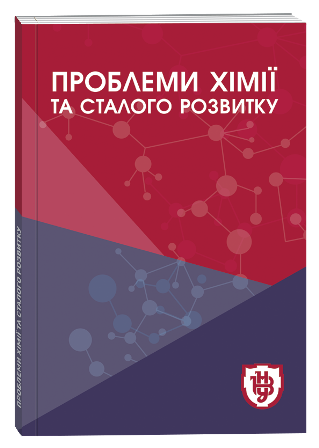EVALUATION OF ANTIMICROBIAL ACTION OF CHALCOGEN-CONTAINING PYRROLO[1,2-а]QUINAZOLIN-5(1H)-ONES
DOI:
https://doi.org/10.32782/pcsd-2022-1-8Keywords:
pyrrolo[1,2-a]quinazolinones, arylchalcogen-containing pyrrolo[1,2-a]quinazolin-5(1H)-ones, bioscreening, antibacterial activity, antifungal activityAbstract
The antimicrobial activity of recently synthesized by the authors 1-arylchalcogenylmethyl-substituted pyrrolo[1,2-a] quinazolin-5(1H)-ones was investigated. The introductory part of the article is devoted to the disclosure of the medical and biological potential of angular synthetic analogues of natural pyrrolo[2,1-b]quinazolinones - pyrrolo[1,2-a] quinazolines derivatives, among which compounds with anti-inflammatory, antimicrobial, antibronchial and hypotensive activity, inhibitors of bromodomains of proteins PB1, SMARCA4 and SMARCA2 and PARP - an enzyme that participates in the repair of broken DNA strands have been identified. The general scheme of synthesis of target 1-(arylchalcogenylmethyl)-2,3-dihydropyrrolo[1,2-a]quinazolin-5(1H)-ones based on cyclosulfenylation (selenylation) of 2-(3-butenyl)quinazolin-4(3H)-ones as a key process is given. The latter were obtained by sequential acylation of anthranilamides with allylacetyl chloride and high-temperature cyclocondensation of intermediate 2- (pentenoylamino) benzamides. The obtained results of bioscreening of the synthesized compounds indicate their moderate antibacterial and antifungal activity: the minimum bacteriostatic concentration (MBsK) is in the range of 15.62-125.0 μg / ml, the minimum fungistatic concentration of MfsK = 62.5 μg / ml. When testing pyrrolo[1,2-a]quinazolin-5(1H)-ones 1a-l against Pseudomonas aeruginosa Proteus aeruginosa ATCC 27853, which can cause severe inflammatory diseases of various organs and tissues and is known to be resistant to many antibiotics, it was found that minimal bactericidal and bacteriostatic concentrations in most of them are at the control level (31.25 μg / ml) and above, and for compounds 1b and 1c MBsK is twice lower and is 15.62 μg / ml. The results obtained allow us to conclude about the possibility of using these compounds for more in-depth research.
References
Mhaske, S.B.; Argade, N.P. The chemistry of recently isolated naturally occurring quinazolinone alkaloids. Tetrahedron. 2006. 62(42). 9787–9826.
Kshirsagar, U.A. Recent developments in the chemistry of quinazolinone alkaloids. Org.Biomol.Chem. 2015. 13(36). 9336–9352.
Shang, X. F.; Morris-Natschke, S. L.; Liu, Y. Q.; Guo, X.; Xu, X.S.; Goto, M.; Li, J.C.; Yang, G.Z.; Lee, K.H. Biologically active quinoline and quinazoline alkaloids. Part I. Med. Res. Rev. 2017. 38(3). 775–828.
. Shang, X. F.; Morris-Natschke, S. L.; Yang, G. Z.; Liu, Y. Q.; Guo, X.; Xu, X.S.; Goto, M.; Li, J.C.; Zhang, G.Z.; Lee, K. H. Biologically active quinoline and quinazoline alkaloids. Part II. Med. Res. Rev. 2018. 38(5). 1614–1660.
He, D.; Wang, M.; Zhao, S.; Shu, Y.; Zeng, H.; Xiao, C.; Lu, C.; Liu, Y. Pharmaceutical prospects of naturally occurring quinazolinone and its derivatives. Fitoterapia. 2017. 119. 136–149.
Dumitrascu, F.; Georgescu, F.; Georgescu, E.; Caira, M.R. Pyrroloquinolines, imidazoquinolines, and pyrroloquinazolines with a bridgehead nitrogen. Advances in Heterocyclic Chemistry. 2019. 155–244.
Alagarsamy, V.; Chitra, K.; Saravanan, G.; Solomon, V.R., Sulthana, M.; Narendhar, B. An overview of quinazolines: Pharmacological significance and recent developments. Eur. J. Med. Chem. 2018. 151. 628–685.
Dumitrascu, F.; Popa, M.M. Pyrrolo[1,2-a]quinazolines: synthesis and biological properties. Arkivoc. 2014. 2014(1). 428–452.
Bell, S.C.; Conklin, G.T. 3,3a-Dihydropyrrolo(1,2-a)quinazoline-1,5(2H,4H)-diones and related intermediates. US Patent 3707468. 1972.
Wolf, E.H.; Daffy, B.J. Quinazoline derivatives. US Patent 3883524. 1975.
Kazemi, S.S.; Keivanloo, A.; Nasr-Isfahani, H.; Bamoniri, A. Synthesis of novel 1,5-disubstituted pyrrolo[1,2-a] quinazolines and their evaluation for anti-bacterial and anti-oxidant activities. RSC Advances. 2016. 6(95). 92663–92669.
Houlihan, W. J. Method of treating bronchial asthma. US Patent 3743733. 1973. 13. Bernstein, J.; Spitzmiller, E.R. Pyrroloquinazoline derivatives. US Patent 3271400. 1966.
Bell, S.C., Wei, P.H.L. Pyrrolo(1,2-alpha)quinazoline-1,5-(2H,3H)diones. US Patent 3475432. 1969.
Krichner, F.K.; Zalay, A.W. 3-Amino-2,3-dihydro-4(1H)quinazolinones. US Patent 3843654. 1974.
Honda, T.; Enomoto, H.; Kawashima, K.; Takaoka, S.; Fujioka, Y.; Matsuda, M.; Ohashi, K.; Fujita, Y.; Hirai, S.-I.; Kurashima, H. Novel compound having PARP inhibitory activity WO Patent 2013008872/A1. 2013.
Sutherell, C. L.; Tallant, C.; Monteiro, O.P.; Yapp, C.; Fuchs, J.E.; Fedorov, O.; Siejka, P.; Müller, S.; Knapp, S.; Brenton, J. D.; Brennan, P. E.; Ley, S. V. Identification and development of 2,3-dihydropyrrolo[1,2-a]quinazolin-5(1H)-one inhibitors targeting bromodomains within the switch/sucrose nonfermenting complex. J. Med. Chem. 2016. 59(10). 5095–5101.
Vangamudi, B.; Paul, T.A.; Shah, P.K.; Kost-Alimova, M.; Nottebaum, L.; Shi, X.; Zhan, Y.; Leo, E.; Mahadeshwar, H.S.; Protopopov, A.; Futreal, A.; Tieu, T.N.; Peoples, M.; Heffernan, T.P.; Marszalek, J.R.; Toniatti, C.; Petrocchi, A.; Verhelle, D.; Owen, D.R.; Andersen, J.N. The SMARCA2/4 ATPase domain surpasses the bromodomain as a drug target in SWI/SNF-mutant cancers: insights from cDNA rescue and PFI-3 inhibitor studies. Cancer Research. 2015. 75(18). 3865–3878.
Karnezis, A.N.; Wang, Y.; Ramos, P.; Hendricks, W.P.; Oliva, E.; D’Angelo, E.; Prat, J.; Nucci, M.R.; Nielsen, T.O.; Chow, C.; Leung, S.; Kommoss, F.; Kommoss, S.; Silva, A.; Ronnett, B.M.; Rabban, J.T.; Bowtell, D.D.; Weissman, B.E.; Trent, J.M.; Huntsman, D.G. Dual loss of the SWI / SNF complex ATPases SMARCA4 / BRG1 and SMARCA2 / BRM is highly sensitive and specific for small cell carcinoma of the ovary, hypercalcaemic type. The Journal of Pathology. 2015. 238(3). 389–400.
Vaskevych, A.I.; Savinchuk, N.O.; Vaskevych, R.I.; Rusanov, E.B.; Vovk, M.V. Arylsulfenyl(selenyl)chlorides in the reactions of chalcogenation/pyrrolo(pyrido) annulation of 2-(3-butenyl)quinazolin-4(3H)-ones. Tetrahedron 2022. In press.
Vaskevych, A.I.; Savinchuk, N.O.; Vaskevych, R.I.; Rusanov, E.B.; Grygorenko, O.O.; Vovk, M.V. PIFAinitiated oxidative cyclization of 2-(3-butenyl)quinazolin 4(3H)-ones – an efficient approach to 1-(hydroxymethyl)-2,3-dihydropyrrolo[1,2-a]quinazolin-5(1H)-ones. Beilstein J. Org. Chem. 2021. 17. 2787–2794.
Yakovychuk, N.D.; Deyneka, S.Y.; Grozav, A.M.; Humenna, A.V.; Popovych, V.B.; Djuiriak, V.S. Аntifungal activity of 5-(2-nitrovinyl)imidazoles and their derivatives against the causative agents of vulvovaginal candidiasis. Regulatory Mechanisms in Biosystems. 2018. 9(3). 369-373.
Некрасова, Л.С.; Свита, В.М.; Глушкевич, Т.Г. Визначення чутливості мікроорганізмів до антибактеріальних препаратів. Методичні вказівки МВ 9.9.5-143-2007. Київ: МОЗ України, Державна сан.-епід. служба, 2007. 79 с.
Волянський, Ю.Л.; Гриценко, І.С.; Широбоков, В.П. Вивчення специфічної активності протимікробних лікарських засобів: методичні рекомендації. Київ: ДФЦ МОЗ України, 2004. 38 с.






